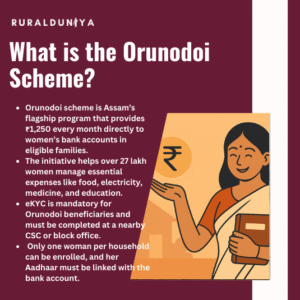SVAMITVA Scheme is a plan implemented by the Ministry of Panchayati Raj that offers a ‘Record of Rights’ to owners of village households. This is done by providing legal ownership cards to property owners through the use of drone technology.
This is a Central Government initiative inaugurated by the esteemed Prime Minister of India on National Panchayat Day, which falls on the 24th of April, 2020.
SVAMITVA Scheme: Unlocking the Secrets
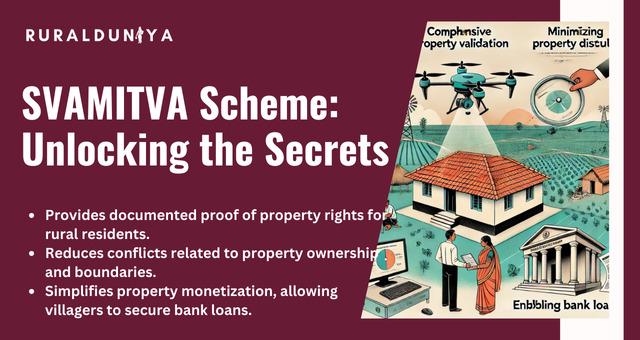
SVAMITVA Scheme is a prominent program launched by the Ministry of Panchayati Raj, in collaboration with NIC, to conduct surveys and create maps of rural areas using innovative technologies.
The objective is to provide a comprehensive property validation solution for rural India and empower them with documented proof of their rights to their residential properties.
The system encompasses various features, such as simplifying the monetization of properties and enabling bank loans, minimizing property-related disputes, and implementing comprehensive village-level planning.
It serves as a crucial step towards attaining true Gram Swaraj and promoting self-reliance in rural India.
SVAMITVA Scheme Objectives
This scheme is motivated by several primary goals, which encompass –
- The establishment of precise land records for rural planning and the mitigation of property-related problems.
- The objective is to enhance the financial stability of rural Indian inhabitants by allowing them to utilize their property as a valuable asset for obtaining loans and other financial advantages.
- The property tax is calculated to be immediately received by the Gram Panchayats (GPs) in states where it is decentralized. Otherwise, it will be added to the state treasury.
- Development of a survey infrastructure and GIS maps that may be utilized by any department for their specific needs.
- To enhance the creation of a higher-quality Gram Panchayat Development Plan (GPDP) through the utilization of GIS maps.
SVAMITVA Scheme Benefits
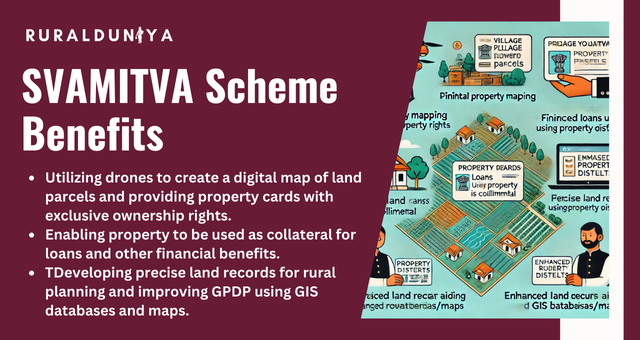
The benefits of yojana are:
- A drone is used to create a digital map of all the land parcels in the inhabited area of the village.
- Development of Property Cards that accurately represent the specific area of each property in the village.
- Exclusive ownership rights to the village household owner.
- Property can be utilized as a financial asset to get loans and acquire other financial advantages.
- Minimize property disputes and legal cases.
- Calculation of Property Tax.
- Development of precise land records for rural planning.
- Improved GPDP – Utilizing Gis Database/Maps for Enhanced Planning and Implementation of Strategies.
SVAMITVA Card
This initiative aims to develop property cards for every landowner under the Survey of Villages and Mapping with Improvised Technology in Village Areas.
This will assist them in providing an authoritative document to financial institutions in the event that they wish to utilize their land/property as collateral in the future.
SVAMITVA Scheme Drone Survey
This scheme aims to utilize drone survey technology in partnership with the Ministry of Panchayati Raj, Government of India, State Revenue Department, and Survey of India to create accurate residential rights records for the rural population.
SVAMITVA Yojana States List
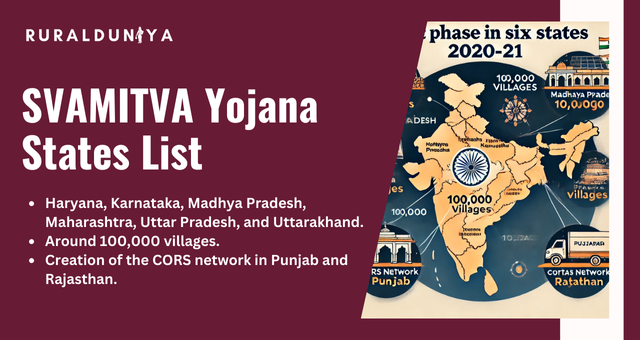
The pilot phase is planned to take place in the year 2020-21. The Pilot Phase will be expanded to include six pilot States: Haryana, Karnataka, Madhya Pradesh, Maharashtra, Uttar Pradesh, and Uttarakhand.
This expansion will encompass around 100,000 villages. Additionally, the creation of the CORS network is planned for two States: Punjab and Rajasthan.
SVAMITVA Scheme Apply Online
Apply procedure of yojana –
Step 1: Request permission to survey, then hold a Gram Sabha to tell people on the timetable, methods, and benefits.
Step 2: Government assets, Gram Sabha land parcels, individual properties, highways, and open plots are identified, marked, and delineated.
Step 3: Survey area public notification and drone flight permission.
Step 4: Ground control points and CORS network are setup.
Step 5: Drone photographs are captured, processed, and used to create digital maps.
Step 6: Village homeowners receive property cards, land parcel ownership verification, and dispute resolution through an inquiry/objection process.
Step 7: The initiative trains and equips government staff to update and save records.
SVAMITVA Eligibility Criteria
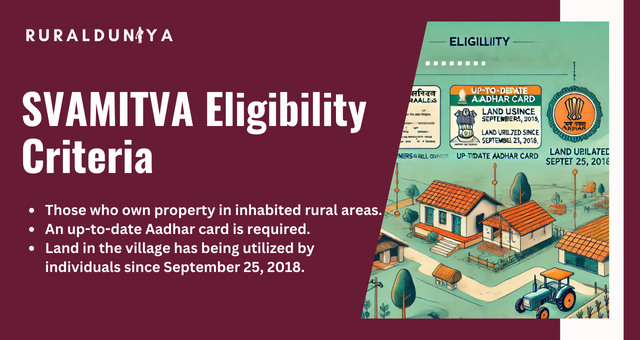
Eligible candidates for the yojana are –
- Those who own property in inhabited rural areas.
- An up-to-date Aadhar card is required.
- Land in the village has being utilized by individuals since September 25, 2018.
Documents Required for SVAMITVA Scheme
List of required documents are –
- Proof of identity of the property owners.
- Evidence of Property Ownership by the Owners.
- Any more documents as mandated by the Revenue Officials.
SVAMITVA Yojana Village List
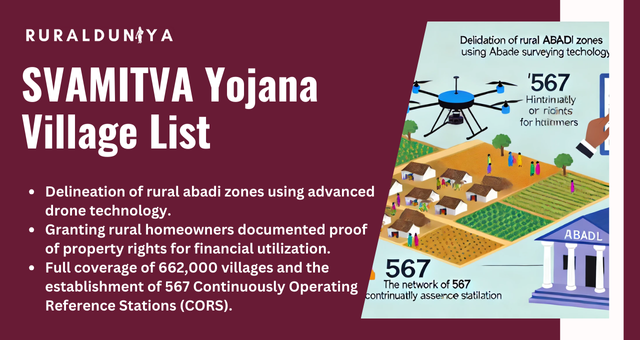
The delineation of rural abadi zones will be conducted with Drone Surveying technology.
This initiative aims to grant the “record of rights” to rural homeowners in populated villages, allowing them to utilize their property as a valuable financial asset for obtaining loans and other financial advantages from banks.
India has achieved full coverage of around 662,000 villages and has established an extensive network of 567 Continuously Operating Reference Stations (CORS).
SVAMITVA Yojana Online Registration
In order to complete the registration process for the yojana, you can employ the following approaches:
- Visit the official website of the Ministry of Panchayati Raj (eGramSwaraj).
- Select the ‘Login’ option located on the homepage of the portal.
- Choose the option of ‘New User Registration’.
- Please furnish your personal details, such as your full name, residential address, and contact information.
- In addition, it may be necessary for you to furnish certain information on your property ownership in the registration form.
- Thoroughly examine your form before submitting it.
- Upon selecting the ‘Submit’ button, a confirmation receipt with the application number will be made accessible.
SVAMITVA Scheme UPSC
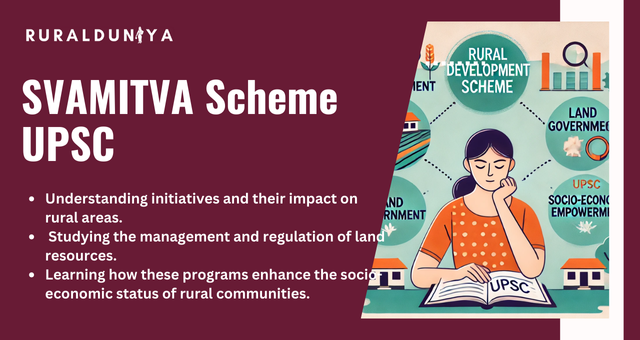
The Scheme is highly significant for UPSC applicants as it tackles crucial matters of rural development, land governance, and socio-economic empowerment.
Comprehending the implementation and effects of rural development programs in India is essential for understanding current efforts towards fair economic growth and governance.
Closing Remarks
SVAMITVA scheme would result in the revision of the ‘record-of-rights’ in the revenue/property registers and the provision of property cards to the property owners.
This would enable the conversion of rural home assets into sources of revenue for credit and other financial services.
Moreover, this would also facilitate the establishment of a definitive assessment of property tax, which would be collected by the Gram Panchayats (GPs) and result in improved public services and infrastructure.
FAQs
What is the use of SVAMITVA scheme?
Drone mapping and ownership certificates are used in the scheme to validate rural Indian properties.
What are the disadvantages of SVAMITVA scheme?
A major limitation of scheme is its failure to incorporate gender considerations into the program.
Who launched Swamitva Yojana?
The Hon’ble Prime Minister introduced SVAMITVA, a Ministry of Panchayati Raj Central Sector Scheme, nationwide on National Panchayati Raj Day, April 24, 2021, after completing the pilot phase in 9 states in 2020–2021.
What is the budget of the SVAMITVA Scheme?
The central government funds SVAMITVA completely. A budget of ₹79.65 crores was allocated for the pilot phase.

Nishank is a social impact enthusiast with a solid foundation in public policy, micro-enterprise, and agribusiness. Growing up in a farmer’s family has given him a profound connection to rural communities, fueling his passion to empower people towards self-reliance. He completed his undergraduate studies at the Delhi University and earned a master’s degree in Rural Management from National Institute of Rural Development & Panchayati Raj in Hyderabad.


